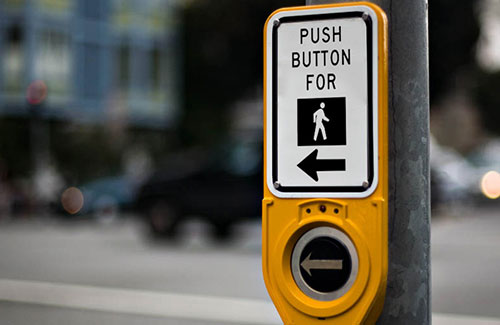当前位置: Language Tips> 英语学习专栏
生活中,按钮无处不在,门铃、自动售货机、计算器、电话……按下按钮,便会产生变化,我们对此再熟悉不过了。然而偏偏有一些按钮,不管你怎么按,就是没反应,比如说美国电梯里的关门键、人行道过街按钮、办公室恒温计按钮等。这些形同虚设的按钮有何存在的意义呢?这里面还真有点儿学问。

By Christopher Mele 鹿尤 选注
It is a reflex born of years of habit: You see a button, press it and then something happens. The world is filled with them, such as doorbells, vending machines, calculators and telephones. But some buttons we regularly rely on to get results are mere artifices—placebos that promote an illusion of control but that in reality do not work. No matter how long or how hard you press, it will not change the outcome. Be prepared to be surprised—and disappointed—by some of these examples.
Door-close buttons on elevators
Pressing the door-close button on an elevator might make you feel better, but it will do nothing to hasten your trip.
Karen W. Penafiel, executive director of National Elevator Industry Inc., a trade group, said the close-door feature faded into obsolescence a few years after the enactment of the Americans with Disabilities Act in 1990. The legislation required that elevator doors remain open long enough for anyone who uses crutches, a cane or wheelchair to get on board, Ms. Penafiel said in an interview. “The riding public would not be able to make those doors close any faster,” she said. However, the buttons can be operated by firefighters and maintenance workers who have the proper keys or codes.
No figures were available for the number of elevators still in operation with functioning door-close buttons. Given that the estimated useful life of an elevator is 25 years, it is likely that most elevators in service today have been modernized or refurbished, rendering the door-close buttons a thing of the past for riders, Ms. Penafiel said.
Take heart, though: The door-open buttons do work when you press them.
Crosswalk signals
New Yorkers (those who don’t jaywalk, that is) have for years dutifully followed the instructions on the metal signs affixed to crosswalk poles:
To Cross Street
Push Button
Wait for Walk Signal
But as The New York Times reported in 2004, the city deactivated most of the pedestrian buttons long ago with the emergence of computer-controlled traffic signals. More than 2,500 of the 3,250 walk buttons that were in place at the time existed as mechanical placebos. Today there are 120 working signals, the city said.
About 500 were removed during major construction projects. But it was estimated that it would cost $1 million to dismantle the nonfunctioning mechanisms, so city officials decided to keep them in place. Most of the buttons were scattered throughout the city, mainly outside of Manhattan. They were relics of the 1970s, before computers began choreographing traffic signal patterns on major arteries. ABC News reported in 2010 that it found only one functioning crosswalk button in a survey of signals in Austin, Tex.; Gainesville, Fla.; and Syracuse.
Office thermostats
The same problem that confronts couples at home—one person’s perception that a room is too cold is another’s that it is too warm—faces office workers as well. Depending on where you work, you might find the thermostat in a plastic case under lock and key, but if you’re lucky you might have control over one.
Well, you might think you have control.
The Air Conditioning, Heating and Refrigeration News reported in 2003 that it asked readers in an informal online survey whether they had ever installed “dummy thermostats.” Of 70 who responded, 51 said they had. One respondent, David Trimble, wrote The News that people “felt better” that they could control the temperature in their work space after a nonfunctioning thermostat was installed. “This cut down the number of service calls by over 75 percent,” he wrote.
Sense of control
Though these buttons may not function, they do serve a function for our mental health, Ellen J. Langer, a psychology professor at Harvard University who has studied the illusion of control, said in an email. “Perceived control is very important,” she said. “It diminishes stress and promotes well being.”
John Kounios, a psychology professor at Drexel University in Philadelphia, said in an email there was no harm in the “white lie” that these buttons present. Referring to the door-close button on an elevator, he said, “A perceived lack of control is associated with depression, so perhaps this is mildly therapeutic.”
Knowing that pushing these buttons is futile does not mean it will stop people from trying, he added. The reward of the elevator door closing always occurs eventually, he said. “If the door never closed, we would stop pressing the button,” he continued. “But in that case, of course, we would stop using the elevator altogether. So, that habit is here to stay. Similarly, even though I have grave doubts about the traffic light buttons, I always press them. After all, I’ve got nothing else to do while waiting. So why not press the button on the off chance that this one will work?”
Vocabulary
1. 这是由多年习惯形成的一种条件反射。reflex: 反射。
2. vending machine: 自动售货机;calculator: 计算器。
3. artifice: 诡计,欺骗; placebo: (使患者误以为自己在服药从而病情好转的)安慰剂;illusion: 幻觉,假象。
4. hasten: 加速,加紧。
5. fade into: 逐渐转弱而进入(某种状态);obsolescence: 废弃,淘汰;enactment: 制定,通过;Americans with Disabilities Act: 《美国残疾人法案》。
6. legislation: 立法;crutch: 拐杖;cane: (尤指带弯柄的)拐杖。
7. maintenance: 维修。
8. 没有确切数据显示还有多少电梯的关门键仍然管用。
9. refurbish: 翻新,整修;render: 使成为,致使。
10. take heart: 振作。
11. jaywalk: 乱穿马路;dutifully: 忠实地;affix: 使固定,贴上;pole: 杆,柱。
12. deactivate: 停止使用,使无效;pedestrian: 为行人而设的;emergence: 出现。
13. dismantle: 拆除,拆卸;mechanism: 机器,机械装置。
14. scatter: 分散,散开。
15. 它们是20世纪70年代的产物,之后电脑开始编制主干道的交通信号模式。relic: 遗留物;choreograph: (精心)计划,设计;artery: 干道。
16. thermostat: 温度调节器,恒温器。
17. perception: 感觉。
18. dummy: 仿造的,假的。
19. diminish: 减少,减小。
20. white lie: 善意的谎言。
21. 感到自己无力控制还与抑郁有关,因此,这或许是一种温和治疗法。therapeutic: 治疗性的。
22. futile: 无效的,徒劳的。
23. grave: 认真的,深切的。
24. on the off chance: 对……抱极小的希望,只是碰碰运气。
(来源:英语学习杂志 编辑:董静)
上一篇 : 爱尔兰西行记
下一篇 :
关注和订阅

电话:8610-84883645
传真:8610-84883500
Email: languagetips@chinadaily.com.cn